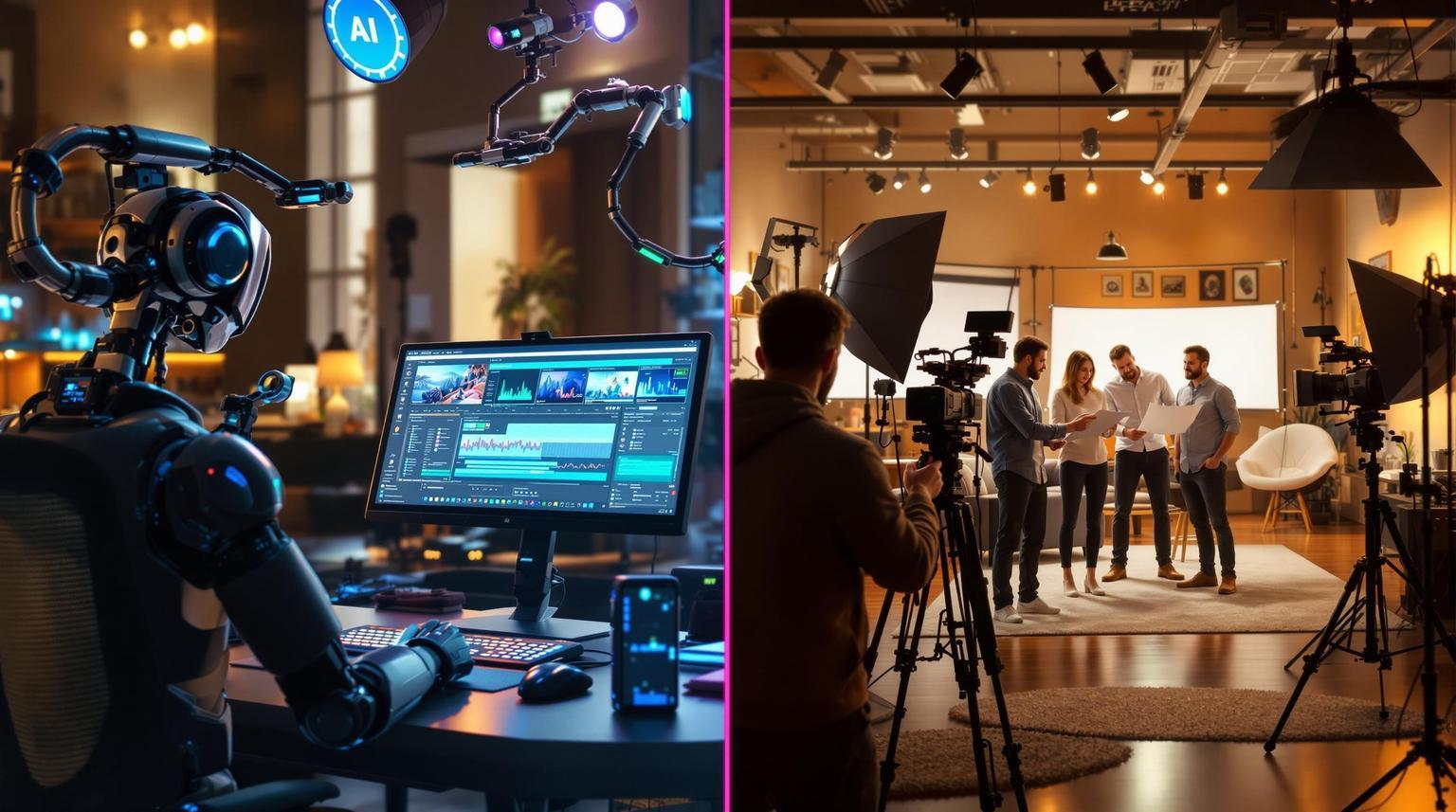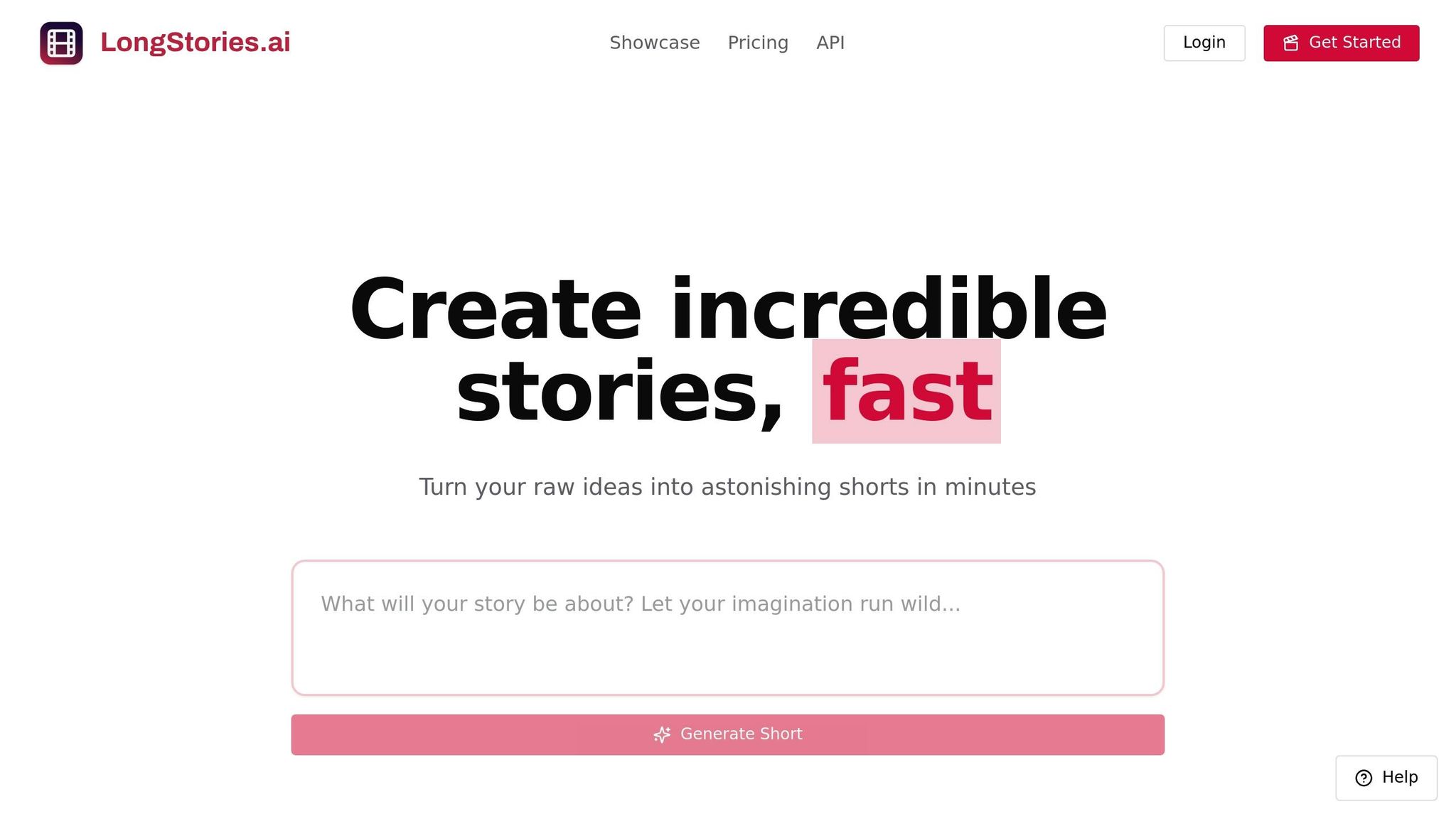
LongStories is constantly evolving as it finds its product-market fit. Features, pricing, and offerings are continuously being refined and updated. The information in this blog post reflects our understanding at the time of writing. Please always check LongStories.ai for the latest information about our products, features, and pricing, or contact us directly for the most current details.
AI vs. Manual Video Production: Cost Comparison
AI video production is faster and cheaper than manual methods, especially for large-scale or repetitive projects. Here's a quick breakdown:
- AI Costs: $50-$200 per video for small projects, $50,000-$200,000 for 1,000 videos.
- Manual Costs: $1,000-$5,000 per video for small projects, $1M-$5M for 1,000 videos.
- Time Savings: AI reduces production timelines by 80%, delivering videos in 1-2 days compared to 2-4 weeks manually.
Quick Comparison
| Category | AI Production | Manual Production |
|---|---|---|
| Cost per Video | $50-$200 | $1,000-$5,000 |
| Team Size | Minimal (creative oversight only) | Large (scriptwriters, editors, etc.) |
| Equipment | None required | $500-$5,000+ |
| Production Time | 1-2 days | 2-4 weeks |
| Scalability | High (costs decrease with volume) | Costs increase with volume |
| Revisions | 5-10% of initial cost | 50-80% of initial cost |
AI is ideal for high-volume, repetitive content like marketing campaigns, while manual methods excel in emotional storytelling and creativity. Many businesses now combine both approaches for the best results.
Cost Breakdown: AI vs Manual Production
Staff and Team Costs
Traditional production relies on a variety of skilled professionals, including:
- Scriptwriters
- Videographers
- Editors
- Specialists, each charging professional rates
This setup leads to high costs, especially for recurring projects.
AI, on the other hand, reduces the need for large teams. While human input is still required for oversight and creative direction, automation handles many tasks, cutting labor costs significantly. For example, one enterprise campaign completed with AI in just a week (compared to several weeks manually) saved 90% of the costs typically associated with traditional seven-figure budgets.
And it’s not just about the people - technology expenses reveal even greater savings with AI.
Tools and Tech Expenses
The equipment and technology costs between manual and AI production differ greatly:
| Expense Category | Manual Production | AI Production |
|---|---|---|
| Initial Equipment | $500-$5,000+ for cameras, lighting, audio gear | No physical equipment needed |
| Software Costs | Monthly subscriptions for editing suites | $20-$100 monthly platform subscription |
| Ongoing Maintenance | Repairs, upgrades, storage | Included in subscription |
| Studio Space | Rental fees, set construction | Not required |
These savings become even more apparent in post-production.
Editing and Rights Management
AI streamlines post-production tasks by offering:
- Automated editing tools
- Access to royalty-free music and footage libraries
- Automated captioning and voiceover generation
- Quick revisions without added costs
For instance, AI can analyze raw footage, pick out key moments, and edit content automatically. This eliminates the need for extensive manual editing and reduces licensing costs, which can add up quickly in traditional production where each asset requires individual licensing.
AI's cost efficiency shines in personalized campaigns. While manual methods see costs rise with each variation, AI platforms can create unlimited versions at almost no additional cost.
How much does Video Production Cost in 2024? | Everything You Need To Know About Videography Prices
Production Costs at Different Scales
Understanding how costs shift with production size highlights the impact of AI in video creation.
Costs for Small Projects
For smaller projects (5-10 videos), the difference in costs between manual and AI-driven production is striking. Traditional manual production costs range from $1,000 to $5,000 per video, covering expenses like videographers, editors, and equipment rentals. For a 10-video project, this adds up to $10,000 to $50,000.
AI significantly lowers these costs, bringing per-video expenses down to $50 to $200. This is achieved through automated scripting (costing $20-$50 compared to $500-$2,000 manually) and streamlined editing (costing $30-$150 compared to $200-$1,500 manually). These savings stem from automation techniques discussed earlier, making AI a game-changer for small-scale projects.
Large-Scale Production Costs
The benefits of AI become even more pronounced with large-scale production.
For campaigns involving 1,000 or more videos, traditional manual production costs often grow linearly - or even exponentially. Producing 1,000 videos manually could cost anywhere from $1 million to $5 million.
In contrast, AI production thrives at scale, drastically reducing costs. As the volume increases, the per-video cost drops due to:
- Automated parallel processing, which aligns with the earlier 80% timeline reduction
- Efficient reuse of assets
- Minimized human error
- Faster implementation of revisions
This efficiency aligns with LongStories.ai's reported 90% cost reduction. For instance, AI can handle a 1,000-video project for $50,000 to $200,000, compared to the $1-5 million required for manual production. That’s a dramatic difference, especially for larger campaigns.
Additional Cost Factors
AI and manual video production each come with indirect expenses that impact budgets in different ways. Traditional methods often bring more unpredictability to the table.
Manual Production Extras
Traditional video production often includes unexpected costs that can inflate budgets by 10-20%. Here are some common expenses:
- Location and equipment fees: Ranges from $100 to over $2,000 per day for permits and specialized gear.
- Music licensing: Costs vary from $50 to over $1,000 per track for commercial use.
- Post-production revisions: These can add 10-30% to the initial budget.
| Common Hidden Costs | Typical Range |
|---|---|
| Location Permits | $100-$1,000/day |
| Equipment Rentals | $500-$2,000/day |
| Music Licensing | $50-$1,000/track |
| Post-Production Revisions | 10-30% of budget |
AI Platform Extras
AI-based production tends to have more predictable costs:
- Monthly subscriptions: Typically range from $50 to $500+.
- API integration: Charges run between $0.01 and $0.10 per request for programmatic access.
- Data storage: Costs $0.02-$0.05 per GB monthly for hosting content.
- Custom models: Developing specialized AI models can cost $10,000 to over $100,000.
Update and Change Costs
The cost of making updates shows a clear difference between these two methods:
- Manual updates: Reshoots can cost 50-80% of the original budget, and editors typically charge $75-$150 per hour.
- AI adjustments: Visual updates are about 5-10% of the initial fees, while text changes are often included in subscription plans.
For larger campaigns that need frequent updates, AI platforms offer a more predictable and scalable cost structure compared to the escalating expenses of traditional production.
These varying cost dynamics play a big role in determining the risk profiles of campaigns - a topic explored next in Performance and Risk Assessment.
sbb-itb-94859ad
Performance and Risk Assessment
Time, quality, and risk all play a role in shaping the costs and outcomes of different video production methods. These factors directly influence both efficiency and exposure to potential risks.
Production Time Comparison
AI video production is significantly faster than traditional methods. For example, creating a 1-2 minute video manually can take 2-4 weeks, whereas AI platforms can deliver similar results in just 24-48 hours.
| Production Scale | AI Timeline | Manual Timeline |
|---|---|---|
| Single Video | 1-2 days | 2-4 weeks |
| 10 Video Variations | 2-3 days | 6-8 weeks |
| 50 Market Localizations | 3-5 days | 3-4 months |
Output Quality Analysis
The quality of output varies based on the production method, with each approach offering distinct advantages. Manual production is better suited for rich storytelling and emotional depth, while AI stands out for its consistency and ability to scale.
Here are the key differences:
- Consistency vs Creative Depth
- Scalable Personalization vs Artistic Execution
- Technical Precision vs Emotional Resonance
This balance explains why 37% of brands opt for a hybrid model, blending AI's efficiency with the creative finesse of manual production.
"AI excels in speed and consistency, but manual methods lead in nuanced storytelling"
Risk Assessment
Each method comes with its own set of risks that can impact the success of a project. Manual production risks, such as budget overruns, highlight the cost advantages discussed earlier.
AI Production Risks:
- Over-reliance on templates, resulting in generic content
- Copyright concerns with AI-generated assets
- Struggles to convey complex emotions
- Dependence on technical systems that may require troubleshooting
Manual Production Risks:
- Costs exceeding initial budgets
- Delays caused by human factors
- Inconsistencies across different projects
- Higher expenses for revisions
Marketers must carefully weigh these risks and performance factors against available budgets to make informed decisions.
LongStories.ai Cost Analysis

LongStories.ai showcases how AI can reduce costs with its straightforward pricing. For instance, the platform charges $1.98 per video under a $99 monthly plan, which includes up to 50 videos. This is a stark contrast to the $1,000-$5,000 typically spent on creating a single short-form marketing video.
The savings grow even more for businesses using API integration. One SaaS company managed to produce 20 explainer videos for just $1,500 - far less than the $40,000-$60,000 it would have cost traditionally.
| Scale | Traditional Cost | LongStories.ai Cost | Savings |
|---|---|---|---|
| Single Video | $1,000-$5,000 | $99/month (up to 50 videos) | Up to 98% |
| API Integration (1,000 videos) | $500,000-$1,000,000 | $10,000-$20,000 | 98% |
| Multilingual Adaptation (5 languages) | $5,000-$10,000 | $500-$1,000 | 80-90% |
AI-powered storytelling tools also make series production far more affordable, cutting costs by 85-90%.
"The API pricing typically ranges from $0.10 to $0.50 per video generated, depending on volume, eliminating hundreds of hours of labor and potentially tens of thousands of dollars in production costs".
AI Video Production vs. Manual Methods: Key Takeaways
AI video production is redefining how businesses approach scalable campaigns, especially when cost efficiency is a priority. However, traditional manual methods still hold their ground in specific scenarios.
Here’s why AI stands out:
- High Output at Lower Costs: AI platforms allow businesses to produce large volumes of content for a fraction of the price compared to manual production.
- Smarter Resource Use: Manual production often demands significant upfront spending, while AI’s subscription-based models are more budget-friendly, particularly for smaller companies.
- Affordable Updates: Need revisions or localized content? AI can handle updates at just 5-10% of the cost of manual adjustments.
That said, the decision between AI and manual production isn’t purely about money. AI shines in creating standardized, high-volume content. But for projects like premium brand videos or intricate storytelling, manual production’s creative touch is still unmatched.
Businesses can benefit from combining both approaches. Use AI for routine, everyday content, and save manual efforts for high-profile projects where creativity and detail matter most. As AI technology continues to evolve, the cost advantage will grow, but there will always be a place for the artistry of manual production.
FAQs
This section addresses common questions about the costs involved in AI video production:
How much does it cost to make an AI video?
The cost of AI video production varies widely. Basic plans start at around $9/month, while professional platforms can go up to $89/month. By comparison, traditional video production methods cost $1,500-$3,000 for a simple video, and more complex projects can exceed $10,000.
Here’s a quick comparison of some popular AI video platforms:
| Platform | Price | Features |
|---|---|---|
| Synthesia | $22/month | Professional avatars, multiple languages |
| InVideo | $15/month | Template library, stock media access |
| Pictory | $19/month | Video editing, auto-subtitles |
What Affects the Cost?
Several factors influence the overall cost of AI video production:
- Length and complexity of the video
- Number of videos needed per month
- Custom assets (e.g., logos, animations)
- Voice-over options
- Storage and hosting needs
- Integration with other tools or platforms
Are There Any Hidden Costs?
Yes, there can be additional expenses, such as:
- Time spent learning the platform
- Custom graphics or animations
- Premium features not covered in basic plans
- Extra storage for larger projects
For large-scale projects, AI video production offers significant savings. For example, creating 100 personalized videos manually might cost $150,000-$300,000, while AI platforms can handle this for just the price of a subscription plus minimal personalization fees.
